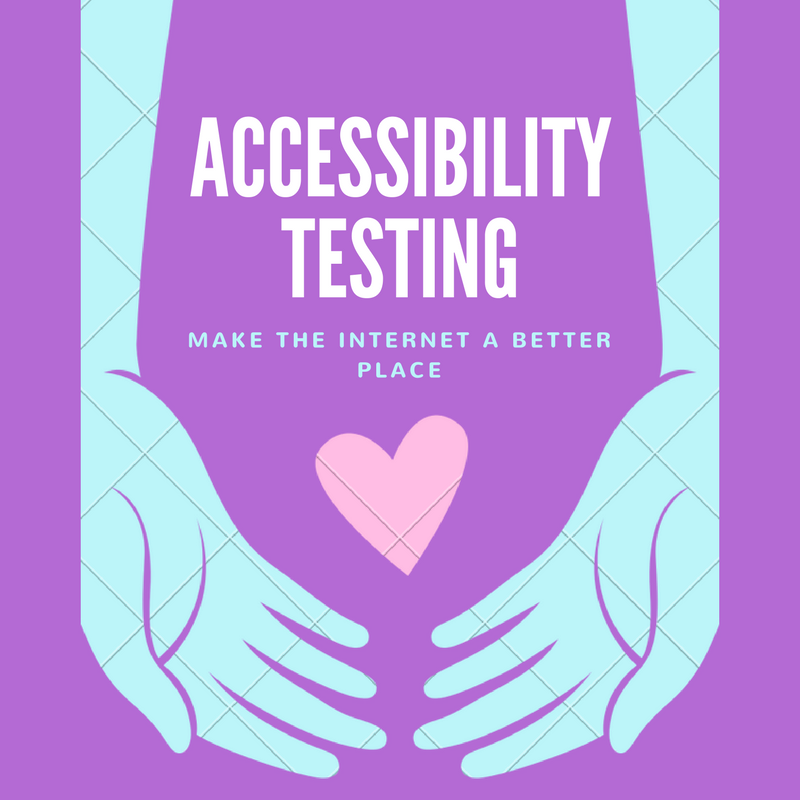
Web accessibility testing is a subset of usability testing where users under consideration have disabilities that affect how they use the web. Wikipedia might tell you more about it.
But why is it so important?

Can you imagine that? There is 1 billion people with disabilities, who might be the users of your application – either web or mobile. Basically, it depends on your testing, if they would feel comfortable with that or not.
What does disability stand for?

Disability is an impairment that may be cognitive, developmental, intellectual, mental, physical, sensory or some combination of these, and that substantially affects a person’s life activities.
In creating apps that satisfy the needs of all users – we should mainly focus on:
UI features:
- color selection
- icons size
- display customization
- ease of use and installation (if needed)
Backed features:
- volume (regulation, presence)
- adjusting to VoiceOver (iOS) and TalkBack (Android)
- correct structure
- guided access
- speech adjustments
- captioning
- audio description
You could obviously wonder if people with disabilities use ‘normal’ apps? Aren’t there special apps or website for them? The answer is – yes – in both cases. They use “normal’ apps, as they need them just like any other person and there is a tiny range of apps dedicated to people with disabilities.
You may also wonder how – for example, a blind person – would be able to use my mobile app. The answer differs in the way that people and disabilities differ, but it doesn’t mean that we are not supposed to think about it while developing or testing.
Google said:
‘Everyone should be able to access and enjoy the web. We’re committed to making that a reality‘
I would completely agree with that. What is more, I personally believe that in societies, where technology is present in everyone’s life and life length extends – this is our duty to create software that is beyond ‘standard’ rules.
As Google tells you about the approach to accessibility – Android and iOS do so. If you don’t know how to start – just follow their advice.
Your accessibility testing should have the following, high-level goals:
- Set up and use the application without sighted assistance
- All task workflows in the application can be easily navigated using directional controls and provide clear and appropriate feedback
Treat such testing as an act of kindness for all the people, who will use your app in the future.

The following tests must be completed in order to ensure a minimum level of application accessibility.
- Directional controls: Verify that the application can be operated without the use of a touchscreen. Attempt to use only directional controls to accomplish the primary tasks in the application.
- TalkBack /VoiceOver audio prompts: Verify that user interfaces control that provides information (graphics or text) or allows user action have clear and accurate audio descriptions when TalkBack /VoiceOver is enabled and controls are focused. Use directional controls to move focus between application layout elements.
- Explore by Touch prompts: Verify that user interfaces control that provides information (graphics or text) or allows user action have appropriate audio descriptions. There should be no regions where contents or controls do not provide an audio description.
- Touchable control sizes: All controls where a user can select or take an action must be a minimum of 48 dp (approximately 9mm) in length and width, as recommended by Android Design.
- Gestures work with TalkBack/VoiceOver enabled: Verify that app-specific gestures, such as zooming images, scrolling lists, swiping between pages or navigating carousel controls continue to work when TalkBack/VoiceOver is enabled. If these gestures do not function, then an alternative interface for these actions must be provided.
- No audio-only feedback: Audio feedback must always have a secondary feedback mechanism to support users who are deaf or hard of hearing.
A friend of mine, who is a blind person but uses smartphone or web on daily basis, said one day that iPhone is waaaay better for her than Android devices. But the question is – if that depends on OS itself and their talking software or on poor Android apps that don’t fully support TalkBack and – to be honest -are annoying even for people whose vision is completely OK. I’m leaving you with this question.
In case of any comments – stalk me on Twitter.

Skype has opened up its website-based consumer beta
to the world, following establishing it generally from the United states and
U.K. previous this 30 days. Skype for Website also
now supports Linux and Chromebook for immediate messaging conversation (no video and
voice nevertheless, these demand a plug-in set up).
The expansion from the beta brings support for a longer listing
of different languages to assist reinforce that international functionality
LikeLike